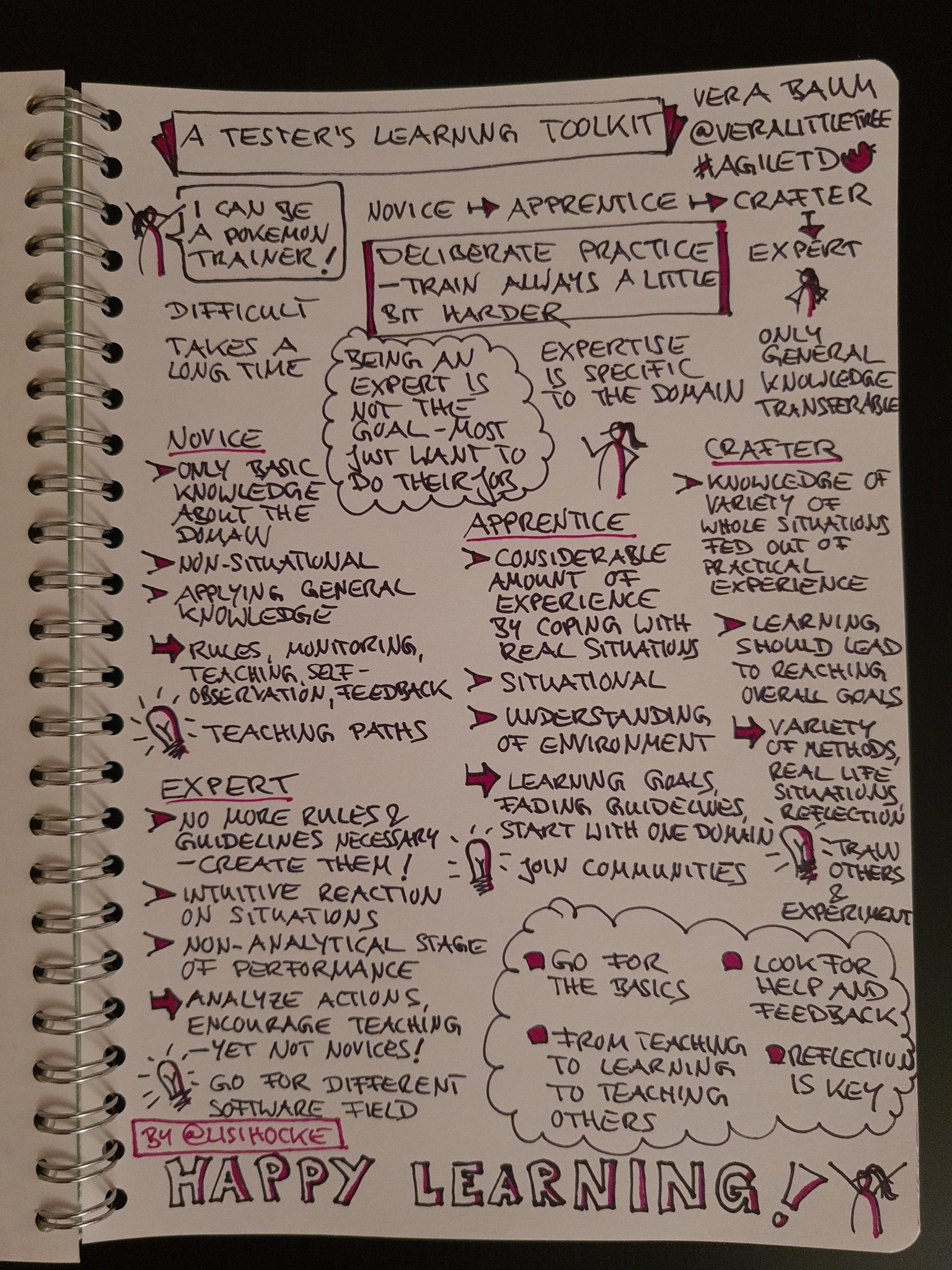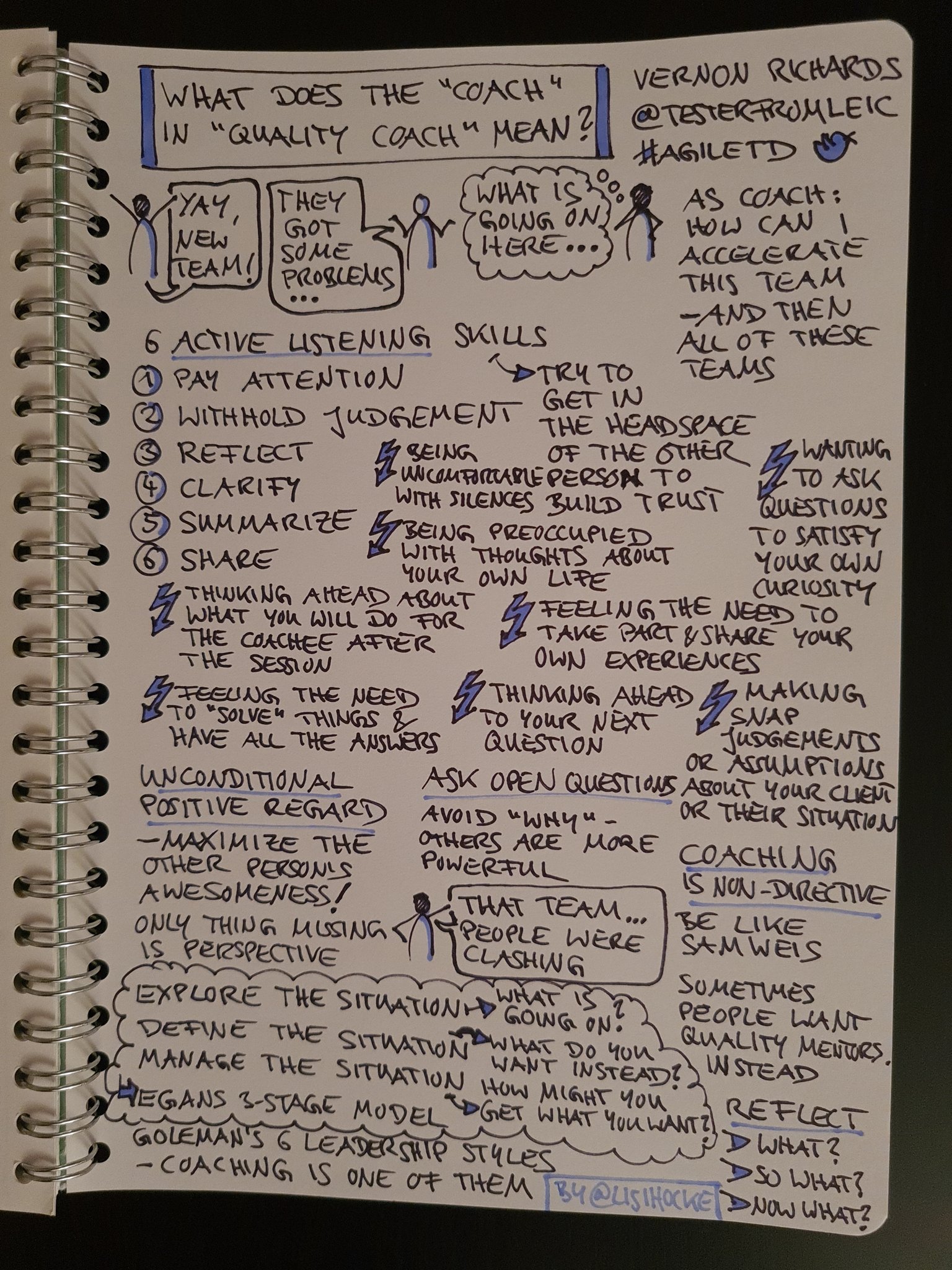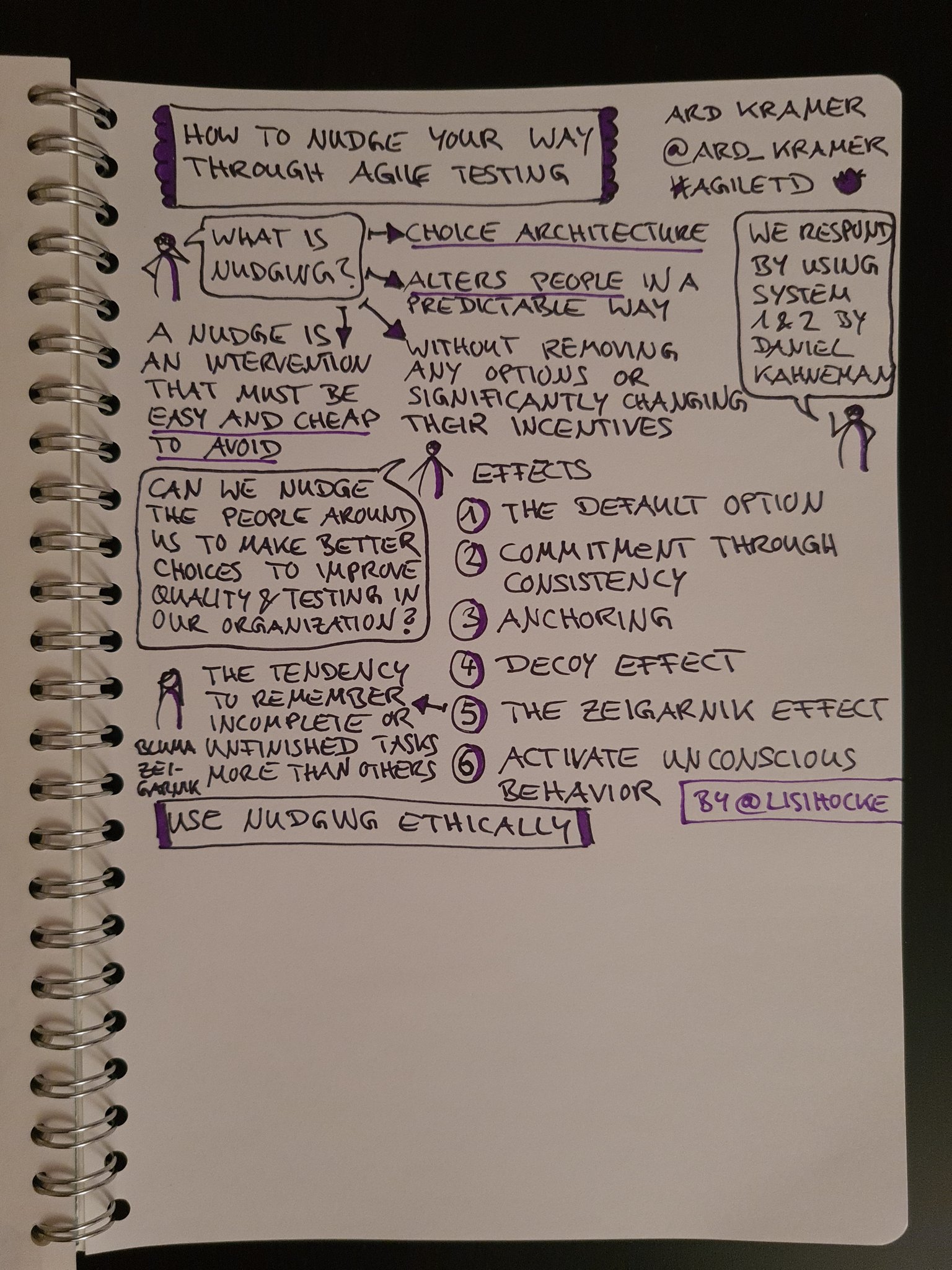After publishing an overview about my journey at Agile Testing days in (Part 1), I’m back with my learning from Keynotes, workshops and talks in this blog. And as promised (Part 3) is coming soon containing an interview with participants.
My Learning from Keynotes
1. Coming to terms with intelligence in machines by Dagmar Monett
- Not everyone has the same emotions, nor the same experience.
- “There are no truly intelligent artifacts in the horizon yet”
Takeaways:
- AI is neither artificial neither not intelligence
- There is no consensus on the definition of AI
- There is no consensus on the definition of intelligence
- The need is to be aware of what AI is and what is not
She emphasizes: There are no truly intelligent artifacts on the horizon yet. WE are the intelligent ones! Be responsible. Create a trust worth Responsible AI (RAI) in all stages and add it to your backlog
- Synergy between AI and SOFTWARE
- AI+SOFTWARE= AI-WARE
- Interdiscipline (psycho + IT …)
- Economic perspective
My real time sketchnote isn’t that efficient to be shared in this blog, but here’s a better summary by Eveline sketchnotes:
2. Agile Comes with a Responsibility for Sustainability by @JuttaEckstein
Sustainability what has to do with agile?
- Software consumes energy : take responsability !
- Companies use: Transparency, Self organization, Continuous learning, Constant customer focus to call it transformation, it’s like there is an end ⛔
People will have expectation – aren’t they agile?
🔍Unconscious expectations!
Which system to explore to find out what they could mean if we look at sustainability aspect ?
- Every team should change the definition of done! so change your definition of done.
- Shift the question we ask in and around the product.
- Testers could be the right people to start doing that!
Jutta Eckstein keynote Agile Comes with A responsibility for sustainability.
Great comment from Janet Gregory,“let’s add it as a QUALITY ATTRIBUTE and think about risks 💡“
3. The Tester’s Learning Toolkit by Vera Baum
Becoming an expert is not everyone’s goal! Only generic knowledge is transferrable.
Vera mentioned the key to get into your goals via training wheels. It’s not necessary to be an expert. It requires ages. GO FOR YOUR OWN TESTING STYLE!

Thank you for @Lisihocke for your sketchnotes!

4. The Power of Coaching for Leading Test Teams by Maryam Umar
Maryam invited the audience for some reflection moments by asking them the below questions aiming to make them conscious of things that they can improve in both their personal and professional life and how both could come together:
- What are my career goals?
- What do I want to change personally?
- What do I value? What do I enjoy?
- What outcomes are within my control?
Here’s a great summary from Eveline’s sketchnote and takeaways:
5. What does the ‘Coach’ in ‘Quality Coach’ mean? by Vernon Richards
When it comes to the “Quality Coach” role, folks seem to have a decent idea of what “Quality” means but what about “Coach”? Often it’s not what people expect and I want to change that!
Vernon
- Coaching is about active listening and providing support, instead of answers and solutions.
For that he described 6 active listening skills: pay attention, withhold judjments, reflect, clarity, summarize and share and he also mentioned the traps of active listening such as being preoccupied with thoughts from your own life, thinking about what to do after the session for the coachee, asking useless questions just to satisfy your curiosity, feeling the need to take part and share your own experiences, feeling the need that you want to solve all the things and you have all answers, thinking ahead of your next question..
It’s also important to understand your leadership style, he mentioned the steps to manage any situation using Egan’s Coaching model
- Explore the situation: When you spot problems, how to make things better? what’s going on ?
- Define the situation: Start to explore things: What would you like to be different? What do you want instead ?
- Manage the situation: What do you want to get? How might you get what you want ?
Here’s another sketchnote by @Lisihocke

6. How to nudge your way through agile testing by Ard Kramer
Ard started defining what nudging is, and how we can benefit from it if we use it in a postive way, “tell a story like a tester; act like a marketer”. He mentioned the systems defined in the book Thinking, Fast and Slow
- System1 (FAST try to assess the situation and delivers update but it’s unconscious, automatic, effortless WITHOUT self-awareness or control “What you see is all there is.”)
- System 2 (SLOW try to seek for new or missing information and help us making decisions, so it’s deliberate and conscious, effortful, controlled mental process, rational thinking)
He mentioned lot of biases and their effects in our life as testers, being aware about nudging and being conscious of those effects, he gave great tips how to use them and when we can get benefits in our testing journey in a good way.
- Example: The “Zeigarnik effect” this is my favorite example, when you take a shower or sleeping or walkign usually you got new ideas related to what you was doing. so how you can get benefit from that as tester ?
Let’s understand first the opposite, when you finish a task and you close it. usualy you forget all the things, as your focus moved automatically to new ones. - What about doing a refinment by in the afternoon for 1h then ask them to prepare their analysis, questions for tomorrow morning, they will certainly come with more ideas. It’s also a great way to apply in root cause analysis if you do it the day after.
You can discover other effects mentioned via this sketchnote done by @Lisihocke:

7. Limitless within our boundaries by João Proença
Unfortunaetly I missed the João’s keynote, as it was just before my session, I took a short break in my room to stay focused and have my full energy.
The good news is that Eveline Moolenaars blogged about it AgileTD 2021 in visuals, and also Lisa Crispin about The beauty of constraints.
My Learning from workshops
1. Paint the product picture by Klaartje and Patrick
In this session, they gave us a helpful way through Product Outline to improve our understanding of the product. As a consequence, it will improve our communication with colleagues and trigger us to think about the best question at the right moment.
We experienced it by having very few details about the product “under test”, but after every assumption, question, discussion we felt more confident about our understanding, we even defined patterns and communicated them across the team in order to make tacit knowledge explicit in a visual way to overcome the complexity of the product.
For every aspect of the product, we identified risks, questions and to-do’s.
This is how we proceeded:
- Start with product acronym
- What do you see?
- What do you know?
- What questions popup?
- What assumptions do you have?
2. Visual problem-solving: the marker strikes back! By Vincent and Eveline
This session is about how to use the power of your marker to untangle complex problems you encounter in your daily work.
They opened the session by asking us to “identify which problems that keep us busy”
Once we mentioned our problems on the paper, we started going deeply through visual thinking.
The agenda was structured around “The Power of the F.O.R.C.E” where they presented the model in general *in the below picture* and then the details related to each phase that we practiced in small groups during the workshop.
- Pose the problem: in this phase, we tried to make our problem explicit, to do that we used the problem pyramid, in the top we put what thing will provide value when addressed adequately, then the measure related to what we defined as a problem. In the bottom, we put the desired measure of the problem that indicates it’s been solved. you can ask yourself a question “if all goal measures are achieved : problem solved ?” when reviewing it, if you find yourself unable to solve it, you can go one step higher and ask again “do the measures fit the problem?”
When doing the problem pyramid, some of us find out that we didn’t identify the problem well enough when going deeply into the 3 layers of the problem pyramid.
Let’s move now to the next step, once the problem is identified:
- Find your entities: try to think about all entities that could have a link with the problem whether processes, objects, people, things, roles,… “WHO?” and what could “WHAT”?
- Organize them _ Reorganize _ Converge: we tried to organize all entities that we put, by mentioning relations and trying then to restructure them if something is missing it’s the moment to add it.
- Explain: “If you can’t explain it simply, you don’t understand it well enough.” Albert Einstein
as the following quote “if you couldn’t explain the problem in a simple way probably you didn’t understand it well enough”, in this step we tried to exchange with another person by explaining our problem using a visual structure such as mindmap, timeline, metaphor …
What I liked in particular, how the speakers designed their slides by hand using the sketchnotes and they also put them in the corner of the room.
More resources: http://www.graphicfacilitator.com/is/meet.htm
3. An Agile Murder Mystery by @Veerla
This is a different and unique workshop compared to the ones I used to attend. From the title I expected it to be funny but didn’t expect that there is a kind of game card called Black Stories that could expand our minds and challenge our thinking !
To sum up it’s about:
- Cryptic riddles or ‘murder mysteries’
- Find out what happened – only yes/no questions are allowed!
Here’s a racket that I make to talk about it in details https://racket.com/emna__ayadi/rh45F
I even add it to my list of games related to testing and agile
advantage of tweets that could describe the real vibes of the conference in real time and stay as good memories, so let’s plug a few tweets.
4. 21st Century Skills for A Tester
”21st century skills for a tester ” our COMBO SESSION, it’s a combination of 30 min presentation and 90 workshop where we shared our journey creating the book about the 4C’s for testers
What are the skills that you need to survive the digital 21st century? Soft Skills! In our talk and workshop, we will tell you how we explored these skills and we need your tips to help others!
We shared how people around the world already apply the 4C’s in their testing journey and imaginations about the future, how they think they can apply those skills in the future and after that we did our workshop (it was my very first workshop in front of international audience, a good challenge after conference talks)
My learnings from talks
1. Growing an Experiment-Driven QUALITY CULTURE by @lisihocke
Lisi mentioned how she managed to grow a quality cuture in the organization through experimentation.
- As a first step look at your team/individuals challenge to understand their struggle, what they are doing and their strengths
- Get inspired and experiment in your context, you can include hypotehsis and then evaluate your exit criteria: it could be “no problem there”, “success”, “didn’t work out let’s rethink” in all the cases ask yourself if teams are ready, eager and committed ? what’s the goal ? tackle the unknown and automate the known, improve people curiosity with more practices and increase their knowledge. What information do we need for each context? Be transparent, raise awareness and experiment with teams !
- Learn from your experiments via converstation with involved members to improve
- Try more invest in quality; quality will work for you ! initiate more interviews with teams, feedback session and experiment approach
- Share remember that there is no solution that fits all
Which impact we want to have and what information we need to have ! Understand needs and find helpful indicators
This will help the team make better decisions !
2. Testing in the imperial database by @Der_Pesse
Here’s my sketchnote for it, you can find more about it: https://developer-sam.de/test_impdb
3. A journey through an adapted ZERO-BUG policy by Simon
4. Fantastic Biases and where to find them in software development by @jrosaproenca and @MichaKutz
In this talk they mentioend different biases and they linked them in a funny way to software development. which makes it very original presentation as everyone of us has his own biases and by becoming aware of their existence we could spot solutions to avoid them or at use them in a good manner !
Let’s take one example:
Affinity biases: tendency to gravitate toward people like ourselves in “appearance”, “beliefs”, “background”, it leads us to be not open to people like us. We may avoid or even dislike people who are different from us.
We need to be careful, It can lead to bad effects, such as it kills creativity when testing, it reduces coming with new fresh ideas when all the group are “similar”
a call for diversity and inclusion to build a high performance team.
I still have more notes for other talks but I decided to publish this blog post and will add the remaining talks that I attended in the coming period, thanks for reading until now I hope this blog allowed you to have the takeaways that I had from AgileTD 🙂 and see you soon in Part (3) blog where attendees will share their experience through a little interview !
Other blogs and useful links:
- https://simonberner.dev/agiletd21
- https://lisacrispin.com/2021/12/29/experiment-driven-quality/
- https://lisacrispin.com/2021/12/21/learning-how-to-be-an-ally-to-nonbinary-folk/
- https://lisacrispin.com/2021/12/08/the-beauty-of-constraints/
- https://elizabethzagroba.com/posts/2021/agile_testing_days_2021/
- https://www.infoq.com/articles/software-development-learn-aviation/
- https://www.infoq.com/news/2022/01/better-tech-leader-coaching/
- https://www.infoq.com/articles/remote-ensemble-working-experiment/
- https://www.infoq.com/news/2021/11/zero-bug-policy/
- https://www.infoq.com/news/2022/01/better-tech-leader-coaching/
- https://www.infoq.com/news/2021/11/cognitive-biases-software/
- https://djdegrood.wordpress.com/2021/11/17/workshop-on-built-in-quality-at-the-agile-testings-days/
